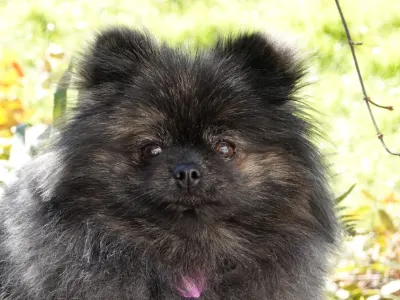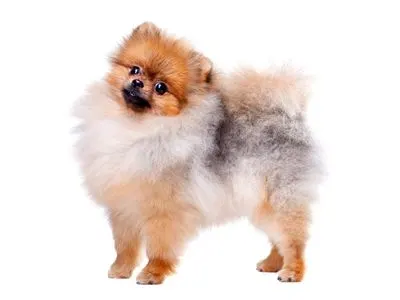The toy dog, known as the Brindle Pomeranian, is streaked with gold and filled with a lively and bold personality. They come from Central Europe, specifically from Poland and Germany.
Descending from large sled dogs to the now very tiny breed, they may be small, but their large roots show up in their personality. This adorable, furry family companion is the perfect size for those who live in big cities or apartments.
Your neighbors might not be too happy with all the barking, but with enough playtime and exercise, your Pomeranian will be the happiest pet in that complex.
What is a Brindle Pomeranian?
The Pomeranian is known as a toy dog, due to its very small size. Around 7 to 9 inches tall, and only weighing between 3 and 7 pounds, this small breed dog comes with a big personality. True to its nature, this tiny breed can be a very vocal but loyal companion.
The Brindle Pomeranian can be easily recognized due to their distinctive coats. They have an adorable fox face with ears that are always perked up and ready to alert you to changes in the vicinity. The thick and rounded coat on their bodies showcases their origins for being able to withstand the snowy winter of northern Germany.
This small breed has a loud personality and a unique and famously recognizable color palette on its coat. What makes a brindle Pomeranian different is the unique pattern displayed on its coat.
The brindle distinctive shows up with darker “tiger stripes”, or mottling, over the base coat of tan or off-white. This unique streaking is unforgettable on a Pom and is some of the rarest colorings in the breed.
For more information on brindle dog breeds, check out our Best Brindle Dog Breeds article!
History of Pomeranians
The origin of a Pomeranian is considered to be from the German Spitz. According to Pomeranian.org, the breed comes from a long line of Artic working dogs that would discover regions of northern Germany and regions of Poland.
While the exact origin of a Pomeranian is unknown, in 1888 they were recognized as an official breed by the AKC and then recognized by England in 1891.
The exact origin of the brindle Pomeranian coat isn’t exact. Brindle is a pattern that lays on the coat, but as of recent years has become more recognizable in this small dog breed.
What kind of Coat does a Pomeranian Have?
The Pomeranian can be spotted with its luxurious double coat, silky smooth, and fluffy coat. Its double coat makes it prepared and ready to withstand any harsh cold winter days.
The Pomeranian has two coats of fur. One is long and fluffy, while the other is a short undercoat. The two blend as layers and form a protective barrier from outside elements.
Typically, your Pomeranian will shed 2 times a year. This means that with so much of its inner layer gone, the outer hairs that stick up will be gone, too. This makes the coat lie flat against the dog’s body, making fluff disappear.
While your Pomeranian’s fluffy fur won’t always be there, the same goes for its soft silky coat. The softness will always be there, just not as much as you might remember from the days when your Pomeranian was a puppy. The soft puppy fur will fall out and be replaced with a new double-layer coat.
When your pup matures, it grows its second, dense layer of short fur and an outer layer of guard fur on top. These dense, short layers can be thicker and rougher and the softness can wear off in time.
Brindle Pomeranian Coat Colors

As with any other coat and color pattern, the brindle pattern is a genetic trait that is created by a combination of specific genes. The different variations of genes create a different pattern for each dog.
The AKC recognizes 24 acceptable Pomeranian colors in the official breed standard, 3 of which are brindle:
- Black and Brindle
- Brindle
- Blue Brindle
Brindle
The Brindle Pomeranian has a darker undercoat with lighter stripes, mottled brown stripes, and spots, or a lighter undercoat with darker streaks.
This unique coloring is eye-catching and memorable due to the rarity of this color pattern. The genes that create brindle coloring make the exact brindle pattern unique to each dog and impossible to predict.
Black Brindle
The black Pomeranian is one of the rarest colors to find in a Pomeranian.
The term ‘reverse brindle’ is used to describe a dog with a high concentration with darker stripes.
The lighter stripes that are either brown, tan, or beige, seem to sit on top of the darker base that can be black or a very dark brown.
Blue Brindle
A unique and beautiful color combination with a gorgeous pattern, the blue brindle Pomeranian is similar to a regular brindle pattern or the black brindle.
Blue brindle is like a regular brindle pattern, but with a dominant color of blue, and fewer reds, oranges, tan, browns, and other darker colors in the base.
The blue brindle Pomeranian is much rarer than regular brindles. Just as the lavender color on a Pomeranian is considered one of the rarest forms, this combination of light blue, gray, tan, beige, and white colors creates a pattern unlike any other.
Pomeranian Personality
The personality type of a brindle Pomeranian can be easily described as:
- Lively
- Bold
- Playful
- Sociable
- Active
- Friendly with humans and other dogs
- Overall a very extroverted animal
Pomeranians are a feisty breed. They’re known to be very playful and cheery, but their favorite activity is to be the center of attention.
They’re famous for their high-pitched bark, and it can definitely be yappy, so if you live in an apartment, your neighbors might not be too happy about it. We recommend obedience training with your Pom from puppyhood to bring out its best personality.
They have extremely sociable personalities with dogs and humans. Taking the time to bring them to places like dog parks, public parks, public beaches, or even play dates will help with their overall mood and exercise needs.
Socializing your Pomeranian early can also reduce any aggressive behaviors from your small companion. This will help make walks and introductions easier, whether to strangers or other new dogs.
Going along with Pomeranians having strong personalities, naturally they will be very stubborn and headstrong animals. This can make them a difficult breed to train.
According to the AKC, brindle Pomeranians have an “inquisitive personality” that helps them learn tricks, commands, and obedience quickly. They’re also on the higher level of being protective.
Exercise Needs

This tiny dog with a large amount of energy requires more exercise than you might expect. To maintain good health for your Pomeranian, the proper amount of exercise is a much-needed requirement.
When a Pomeranian doesn’t get the needed exercise it requires, it can lead to some serious behavioral issues. These can include pent-up anger, resentment, disobedience, and even running away.
When Pomeranians are puppies, much of their exercise is playtime and mental stimulation. Training for obedience, understanding commands, house training, and potty training can all exhaust your new pup throughout the day.
The amount of exercise you give your pup can affect its growth. Ensuring that you give it the proper exercise amount will help it grow maturely into its emotional needs and full mental capacity and help it have great physical health.
The best minimum is around 2 walks per day. Keep each walk for at least 20 minutes each time, but never shy away from making them longer. During especially cold days, make sure to keep your Pomeranian warm while out and about.
Each brindle Pom is different, but if they do crave more outside time, try to make the walks either 30 to 40 minutes each time.
If you notice your brindle Pomeranian is getting tired, walking slower, being less sociable, or refusing to walk, then carry them the rest of the way. If a Pom is over-exercised it can become overheated, leading to serious health issues.
Grooming Needs
The grooming needs for a brindle Pomeranian are very simple. With their small size and easy-to-maintain coat, it really won’t take as much work as you might think.
The table below describes the needs for grooming daily, weekly, and monthly.
| Daily | Weekly | Monthly |
| Wipe eyes, and area around eyes | Brush the Coat every 2 – 3 days during light shedding seasons | Apply nose balm if needed |
| At-Home dental cleanings | Apply paw wax | Full bath cleaning every 3-4 weeks |
| Wipe coat | Clean ears every 6 weeks | |
| Brush the coat during heavy shedding seasons | Trim nails every 6 weeks |
Use this table to consider the overall maintenance of your future brindle Pomeranian. While their grooming might seem like a lot, using this chart can help you understand and organize the routine.
Where to Buy a Brindle Pomeranian

Finding a Brindle Pomeranian can seem like a daunting task. With the breed being not common and also up in the price range, getting a Brindle Pomeranian is no easy feat.
To find one you’ll want to research areas that are near you. Look up AKC breeders near you. You’ll want to make sure that the breeder is registered and has properly taken care of the pups and their parents.
Use sources such as bbb.org or the phone number that AKC provides to verify the membership of the breeder.
Don’t forget to check out your local kennel. You never know if you’ll be able to find a Brindle Pomeranian that’s waiting to be adopted by you!
For other adoption services go to websites such as RescueMe.org. There you can find specific breeds that are in your area in a super easy process.
Another source to look at is Pomeranian adoption clubs. These are clubs that specifically help you to find the exact Pomeranian that is right for you.
Always make sure when looking for breeders, adoption clubs, or online sellers, that you’re finding a source that is trustworthy and honest.
Do Brindle Pomeranians Cost More than a non-brindle Pomeranian?
When you’re looking to adopt a brindle Pomeranian, it’s likely that the first thing that came to your mind was how much it might be. The overall cost of owning a dog is something you need to calculate for the long run.
The cost of adoption for a standard Pomeranian that’s non-brindle is priced between $500 to $1,500. When you want to adopt a rarer color such as black, blue, gray, or lavender the price can go up dramatically.
The same is with unique color patterns, such as brindles. The brindle pattern can showcase some of the rare colors, and truly can create a unique coat.
The average cost of a brindle Pomeranian is between $1,500 to $2,000 and sometimes even more. The price can go even higher depending on if the Pomeranian has a black brindle, which is more common, or a blue brindle which is more on the rare side of the spectrum.
A brindle Pomeranian, although beautiful, is more expensive than the average and standard classified Pomeranian. With around a $1,000 difference, it can help out in perspective if a brindle Pomeranian is the dog breed for you.
To give a clearer look at the first adoption price difference between a standard Pomeranian and a brindle Pomeranian look at the table below:
| Standard Pomeranian (non-brindle) Price Range | $500 to $1,500 |
| Brindle Pomeranian Price Range | $1,500 to $2,000 |
Always remember that when looking for a pet, it’s an investment for the many years of happiness and joy to come.
Pomeranians at a Glance
Below is a table summarizing the basic statistics of a Brindle Pomeranian.
| Weight | 3 – 7 lbs |
| Height | 10 – 11 in |
| Lifespan | 12 – 16 years |
| Exercise Requirements | At least 20 minutes a day |
| Grooming Requirements | Moderate, easy to maintain |
| Energy Level | Very High |
| Coat Characteristics | Medium length with a double coat |
| Colors | Golden, White, Tan, Brown, Black, Red, Gray, Lavender, and Orange |
Before jumping to adopt your very own Brindle Pomeranian, it’s important to consider every factor that you can. Considering things such as their size, coat, and personality type can help you decide if the Pomeranian is a good option for you, your family, and your lifestyle.



